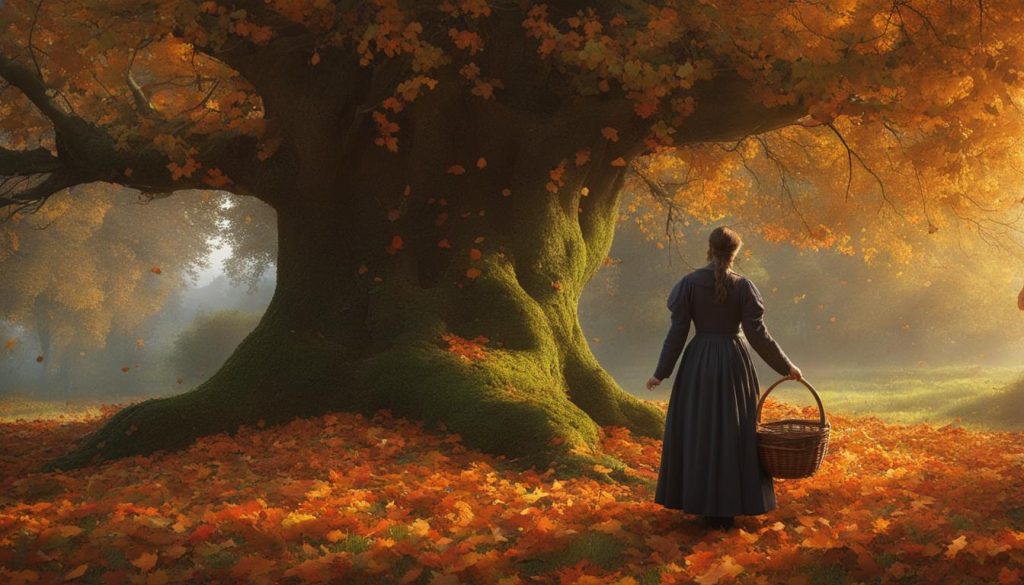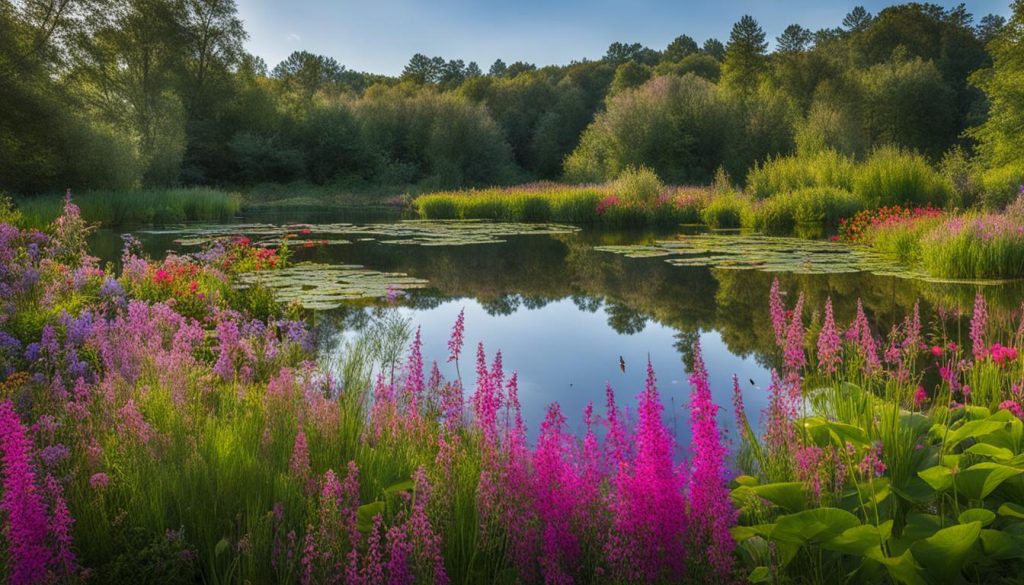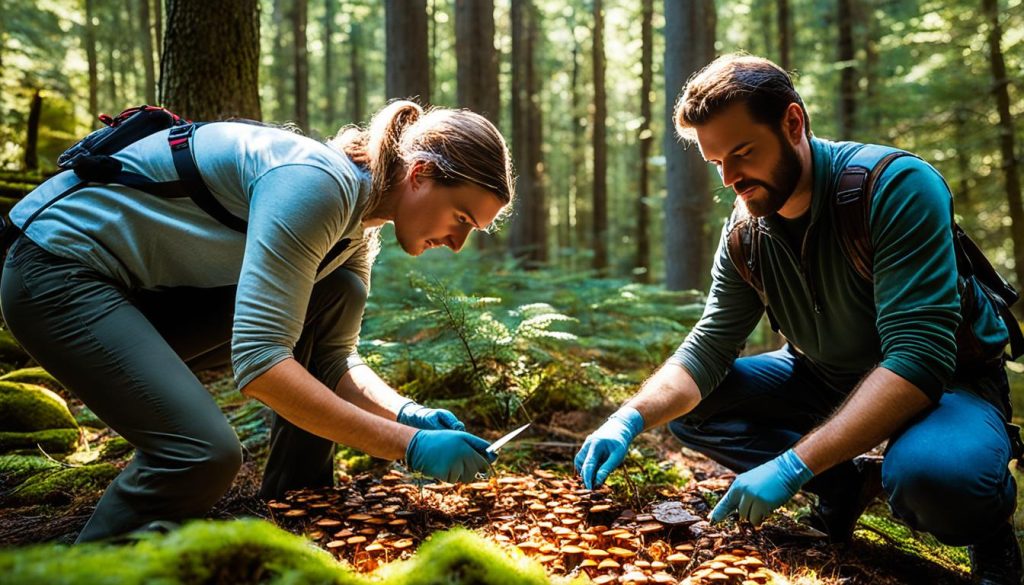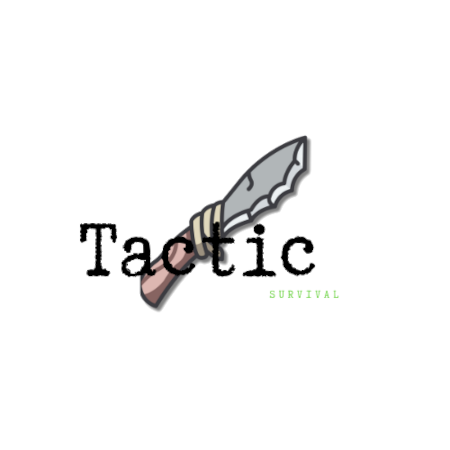Did you know that there are thousands of edible plants in the wild, waiting to be discovered and savored? In a world where we buy most of our food from supermarkets, reconnecting with nature’s vast pantry through wild food foraging can be a truly transformative and rewarding experience. From the lush forests to the scenic meadows, edible treasures are hidden all around us, just waiting to be found.
Key Takeaways:
- Wild food foraging offers a unique opportunity to connect with nature and discover the diverse flavors of the wild.
- There are thousands of edible plants in the wild that can be safely harvested and incorporated into delicious meals.
- Proper identification, ethical foraging practices, and respect for the environment are essential when foraging in the wild.
- By foraging sustainably, we can enjoy the bounties of nature while preserving and protecting our natural ecosystems.
- Join me on a journey through this comprehensive guide to learn how to safely and successfully forage for wild foods.
The Basics of Wild Food Foraging
Before embarking on your foraging adventure, it’s essential to understand the basics. In this section, I will provide you with valuable information and guidelines to ensure a successful and safe foraging experience.
Rules and Ethics of Foraging
When foraging for wild food, it’s important to follow certain rules and ethical practices. Respect the environment by only taking what you need and leaving enough for the plants and wildlife. Make sure you have the landowner’s permission if you are foraging on private property. Additionally, familiarize yourself with any local regulations and restrictions regarding foraging in protected areas.
General Safety Precautions
Foraging in the wild can be a wonderful experience, but it’s crucial to prioritize your safety. Stay on designated paths and trails to avoid hazards such as poisonous plants, rough terrain, or encounters with wildlife. Always wear appropriate clothing and footwear, and carry a first aid kit with you. If you’re unsure about the safety or edibility of a plant, consult a reliable field guide or seek guidance from an experienced forager.
Avoiding Toxic Environments
When foraging, be mindful of potential environmental contaminants. Avoid areas that may have been exposed to pollutants or chemicals, such as industrial sites, heavily trafficked roadsides, or areas sprayed with pesticides. Choose locations that are far from potential sources of contamination, ensuring the safety and quality of the wild foods you harvest.
Positive Plant Identification
Accurate plant identification is crucial to differentiate between edible and toxic species. Invest time in studying and understanding the characteristics of plants you plan to forage, including their leaves, stems, fruits, and growth patterns. Attend workshops or join local foraging groups to learn from experienced foragers. Remember, never consume a plant unless you are 100% certain of its positive identification.
When and Where to Forage
The timing and location of your foraging expedition are essential factors for a successful harvest. Different plants have specific seasons when they are at their peak in terms of flavor and nutritional value. Research the best times to forage for specific wild foods, taking into consideration the climate and region you are in. Look for habitats where your targeted plants thrive, such as wooded areas for mushrooms or sunny meadows for wildflowers.
Equipment and Foraging Techniques
A few essential tools and techniques can make your foraging experience more efficient and enjoyable. Some recommended equipment includes a sturdy backpack, comfortable gloves, a knife for harvesting, bags or containers for collecting, and a reliable field guide. Learn techniques for properly harvesting plants, such as using shears or scissors to trim leaves without damaging the main plant. Take care to minimize your impact on the environment by not disturbing surrounding flora and fauna.
Foraging Tips and Best Practices
To enhance your foraging skills, here are a few additional tips:
- Start with familiar plants: Begin your foraging journey by focusing on plants that are easily identifiable and have no poisonous counterparts. Build your knowledge and confidence gradually.
- Respect the land: Obtain permission before foraging on private property, respect protected areas, and only harvest a reasonable amount to maintain the ecosystem balance.
- Leave no trace: Be mindful of your footprint in nature. Avoid trampling plants, disturbing wildlife, or leaving any litter behind. Leave the environment as you found it.
- Continual learning: Foraging is a lifelong learning process. Keep expanding your knowledge by attending workshops, joining foraging groups, and experimenting with new plants and recipes.
Now that you have a solid understanding of the basics, you’re ready to explore the world of wild food foraging. Armed with this knowledge, you can confidently identify edible plants, employ the best foraging practices, and embark on a sustainable journey of discovering nature’s bounties.
Foraging Trees, Vines, and Weeds
Trees, vines, and weeds are abundant sources of wild edibles. In this section, we’ll explore various species of trees such as basswood, black walnut, oak, and pawpaw, along with their edible parts. Let’s discover the rich flavors and unique textures these trees have to offer.
Tree Foraging
When foraging trees, it’s important to identify the edible parts and harvest them sustainably. Here are some popular tree species and their edible parts:
| Tree Species | Edible Parts |
|---|---|
| Basswood | Leaves, flowers, inner bark |
| Black Walnut | Nuts |
| Oak | Acorns |
| Pawpaw | Fruit |
Remember to only harvest from healthy trees and leave enough for wildlife and future foragers.
Vine Foraging
Vines also provide delicious wild edibles. Let’s explore some edible vines and how to harvest them:
- Wild Grapes: Look for clusters of ripe grapes and gently pluck them from the vine.
- Greenbrier: Harvest the tender stems and young shoots, which can be eaten raw or cooked.
- Groundnut: Dig into the soil near the vine’s base to find the edible tubers.
Weed Foraging
Weeds often go unnoticed, but they can be nutritious additions to your foraged harvest. Here are some edible weeds to consider:
- Dandelion: Harvest the leaves for salads or the roots for teas and infusions.
- Clover: Enjoy the young leaves in salads or use the dried flowers for herbal teas.
- Chickweed: Gather the tender shoots and leaves to add a touch of freshness to your dishes.

Exploring trees, vines, and weeds opens up a world of wild flavors and culinary possibilities. Remember to always properly identify plants before consumption and practice sustainable foraging techniques. Happy foraging!
Foraging Wildflowers and Aquatics
Wildflowers and aquatic plants offer a unique opportunity for wild food foraging. Not only do they add beauty to the landscape, but they also provide nutritious and delicious options for our meals. In this section, we will explore the identification and culinary uses of wildflowers such as chicory, goldenrod, and wild carrot. We will also dive into the world of edible aquatic plants like arrowhead, cattails, and lotus.
Let’s start with wildflowers. These vibrant blooms not only enhance the visual appeal of our surroundings but also bring distinct flavors and health benefits to our plates. The following table provides a glimpse into a few commonly foraged wildflowers, highlighting their culinary uses:
Foraged Wildflowers and Their Culinary Uses
| Wildflower | Culinary Uses |
|---|---|
| Chicory | Leaves: Salads, sautéed, or brewed as tea. Roots: Roasted and used as a coffee substitute. |
| Goldenrod | Flowers: Infused into honey, dried for tea, or used as a garnish. Leaves: Crumbled into soups, stews, or as a seasoning. |
| Wild Carrot | Flowers: Added to salads or used as a garnish. Roots: Cooked, roasted, or pickled as a flavorful addition to dishes. |
Now let’s turn our attention to aquatic plants. These water-dwelling wonders not only provide unique flavors but also showcase a variety of textures in our culinary creations. Below is a list of edible aquatic plants and their potential uses:
Edible Aquatic Plants and Their Culinary Uses
- Arrowhead: Tubers can be boiled, roasted, or mashed for use in soups and stews.
- Cattails: Shoots can be used as a substitute for asparagus, and roots can be cooked like potatoes or ground into flour.
- Lotus: Seeds can be roasted or ground into flour, and young leaves can be used as wraps or added to salads.
By incorporating wildflowers and aquatic plants into our cooking repertoire, we can savor their unique flavors and reap the nutritional benefits they offer. The image below showcases the beauty and diversity of these foraged botanicals:

Now that we’ve explored the world of wildflower foraging and aquatic foraging, let’s move on to the next exciting section, where we will delve into the fascinating realm of foraging mushrooms and a variety of other wild foods.
Foraging Mushrooms and Misc. Wild Foods
Mushrooms are a fascinating and diverse group of wild foods. In this section, we will focus on popular edible mushrooms such as chanterelle, morel, and oyster mushrooms. These mushrooms are prized for their unique flavors and textures and are commonly sought after by mushroom enthusiasts.
When foraging for mushrooms, it’s crucial to have proper identification knowledge to distinguish between edible mushrooms and toxic look-alikes. Take the time to familiarize yourself with the characteristics of each edible species and consult a reliable field guide for accurate identification.
One of the most sought-after edible mushrooms is the chanterelle mushroom. Known for its golden color, delicate texture, and apricot-like fragrance, chanterelles are abundant in certain regions during the summer and fall months. These flavorful mushrooms are often used in various culinary dishes, from simple sautés to elaborate pasta recipes.

Wild Food Recipes
If you’re lucky enough to encounter morel mushrooms during your foraging expeditions, you’re in for a treat. Morels are highly sought after for their rich, earthy flavor and distinctive appearance. These conical mushrooms with their spongy, honeycomb-like caps are often found in wooded areas during the spring. They can be enjoyed in a variety of culinary creations, including soups, stir-fries, and stuffed dishes.
Oyster mushrooms, another popular edible species, have a delicate and savory flavor. They can be found growing on decomposing wood or tree stumps, making them relatively easy to locate. Oyster mushrooms are versatile in the kitchen and can be used in stir-fries, soups, or even as a meat substitute in vegetarian dishes.
Aside from mushrooms, there are several other interesting and tasty wild foods that can be foraged. These include lichens, prickly pear cactus, and turkey tail mushrooms. Lichens, a symbiotic fusion of algae and fungi, are used in herbal remedies and teas and can add a unique touch to your culinary creations. Prickly pear cactus offers juicy and refreshing fruits that can be eaten raw or used in desserts and drinks. Turkey tail mushrooms, named for their resemblance to a turkey’s tail feathers, have long been used in traditional medicine and are now gaining popularity in the culinary world as well.
Conclusion
Congratulations on completing this comprehensive wild food foraging guide! Throughout this journey, I have provided you with valuable knowledge and tools to help you explore nature’s bounty in a sustainable way. By engaging in ethical foraging practices and respecting the environment, you can continue to enjoy the delights of wild edibles while preserving their habitats for future generations.
Remember to always prioritize the principles of sustainable foraging. This means only harvesting what you need, leaving enough for the plants and animals that depend on them, and avoiding overexploitation of any specific species. By doing so, you contribute to the preservation of our ecosystems and their delicate balance.
As you venture into the wild, armed with the information and techniques from this foraging guide, be sure to apply caution and positive identification skills. Double-check your findings, and if you’re uncertain about the safety of a plant or mushroom, it’s best to leave it untouched. Safety should always be a top priority when foraging.
Now that you possess the knowledge and confidence to forage sustainably and confidently, I encourage you to continue expanding your culinary horizons. Experiment with new recipes, incorporate wild edibles into your favorite dishes, and share your newfound expertise with others. With every foraged meal, you’ll not only enjoy the unique flavors of nature but also deepen your connection with the environment.
